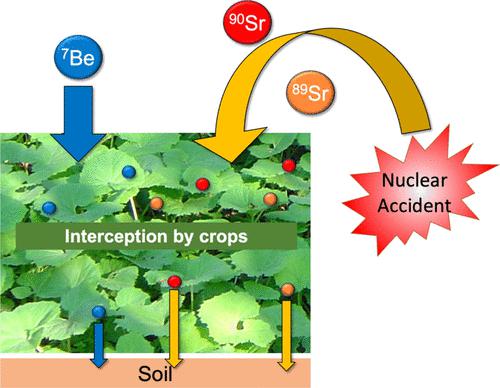当前位置:
X-MOL 学术
›
J. Agric. Food Chem.
›
论文详情
Our official English website, www.x-mol.net, welcomes your
feedback! (Note: you will need to create a separate account there.)
Enhancement of Mass Interception Coefficient Data of Radiostrontium by Leafy Crops Using Global Fallout 90Sr and Naturally Occurring 7Be
Journal of Agricultural and Food Chemistry ( IF 5.7 ) Pub Date : 2022-11-22 , DOI: 10.1021/acs.jafc.2c05705 Keiko Tagami 1 , Shigeo Uchida 1 , Nobuyoshi Ishii 1 , Jian Zheng 1
Journal of Agricultural and Food Chemistry ( IF 5.7 ) Pub Date : 2022-11-22 , DOI: 10.1021/acs.jafc.2c05705 Keiko Tagami 1 , Shigeo Uchida 1 , Nobuyoshi Ishii 1 , Jian Zheng 1
Affiliation

|
When artificial radionuclides are released into the atmospheric environment, one of the important processes by which they affect the human radiation dose is the direct deposition of the radionuclides onto crop surfaces. Because leafy vegetables are consumed while fresh and often raw, the mass interception coefficient [= concentration in food (Bq/kg dry mass (DM) or fresh mass)/total deposition (Bq/m2)] is a key parameter for estimating radionuclide concentrations in crops after the deposition of radionuclides on plant stands. However, such data are still sparse, especially for radiostrontium (89Sr and 90Sr). To enhance the mass interception coefficient data for leafy crops, we used global fallout 90Sr data in leafy crops harvested in 1963–1965 and the deposition data for the corresponding crop growing period. Geometric mean values of the mass interception coefficient of 90Sr for leafy crops were 2.8 m2 kg–1 DM for spinach, 0.60 m2 kg–1 DM for cabbage, and 1.3 m2 kg–1 DM for Chinese cabbage. For comparison, we measured naturally occurring 7Be in giant butterbur leaves, and the results showed that the data were similar to those of 90Sr for spinach. These data were similar to the previously obtained data by single spike radiotracer experiments. Therefore, in the case of nuclear emergency situations, mass interception coefficient data obtained using global fallout 90Sr and/or naturally occurring 7Be should be valuable to estimate radioactivity contamination levels of radiostrontium directly deposited on leafy crops.
中文翻译:

使用全球辐射 90Sr 和自然发生的 7Be 增强绿叶作物对放射性锶的质量拦截系数数据
当人造放射性核素释放到大气环境中时,它们影响人体辐射剂量的重要过程之一是放射性核素直接沉积到农作物表面。由于多叶蔬菜是在新鲜且通常生吃时食用的,因此质量拦截系数 [= 食物中的浓度(Bq/kg 干质量 (DM) 或新鲜质量)/总沉降量 (Bq/m 2 )] 是估算放射性核素的关键参数植物林中放射性核素沉积后作物中的浓度。然而,这样的数据仍然很少,特别是对于放射性锶(89 Sr 和90 Sr)。为了增强叶类作物的质量拦截系数数据,我们使用了 global fallout 901963-1965 年收获的叶类作物的 Sr 数据和相应作物生长期的沉积数据。叶类作物的90 Sr质量拦截系数几何平均值为菠菜 2.8 m 2 kg –1 DM,卷心菜0.60 m 2 kg –1 DM,大白菜 1.3 m 2 kg –1 DM。为了对比,我们测量了蜂斗菜叶中天然存在的7 Be,结果表明与90Sr 菠菜。这些数据与之前通过单尖峰放射性示踪剂实验获得的数据相似。因此,在核紧急情况下,使用全球沉降物90 Sr 和/或自然产生的7 Be 获得的质量拦截系数数据对于估计直接沉积在多叶作物上的放射性锶的放射性污染水平应该是有价值的。
更新日期:2022-11-22
中文翻译:

使用全球辐射 90Sr 和自然发生的 7Be 增强绿叶作物对放射性锶的质量拦截系数数据
当人造放射性核素释放到大气环境中时,它们影响人体辐射剂量的重要过程之一是放射性核素直接沉积到农作物表面。由于多叶蔬菜是在新鲜且通常生吃时食用的,因此质量拦截系数 [= 食物中的浓度(Bq/kg 干质量 (DM) 或新鲜质量)/总沉降量 (Bq/m 2 )] 是估算放射性核素的关键参数植物林中放射性核素沉积后作物中的浓度。然而,这样的数据仍然很少,特别是对于放射性锶(89 Sr 和90 Sr)。为了增强叶类作物的质量拦截系数数据,我们使用了 global fallout 901963-1965 年收获的叶类作物的 Sr 数据和相应作物生长期的沉积数据。叶类作物的90 Sr质量拦截系数几何平均值为菠菜 2.8 m 2 kg –1 DM,卷心菜0.60 m 2 kg –1 DM,大白菜 1.3 m 2 kg –1 DM。为了对比,我们测量了蜂斗菜叶中天然存在的7 Be,结果表明与90Sr 菠菜。这些数据与之前通过单尖峰放射性示踪剂实验获得的数据相似。因此,在核紧急情况下,使用全球沉降物90 Sr 和/或自然产生的7 Be 获得的质量拦截系数数据对于估计直接沉积在多叶作物上的放射性锶的放射性污染水平应该是有价值的。











































 京公网安备 11010802027423号
京公网安备 11010802027423号